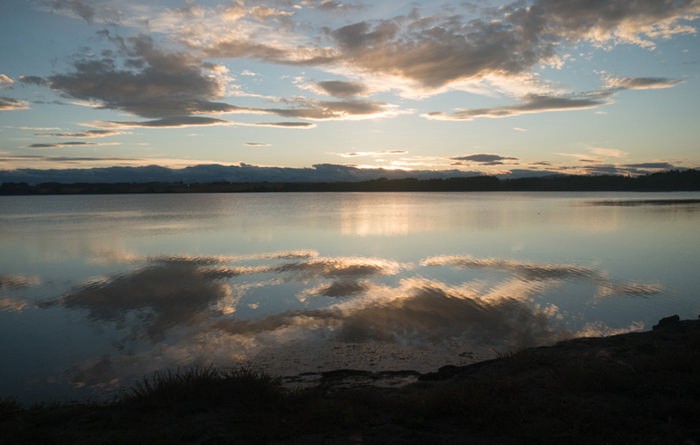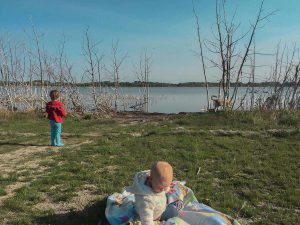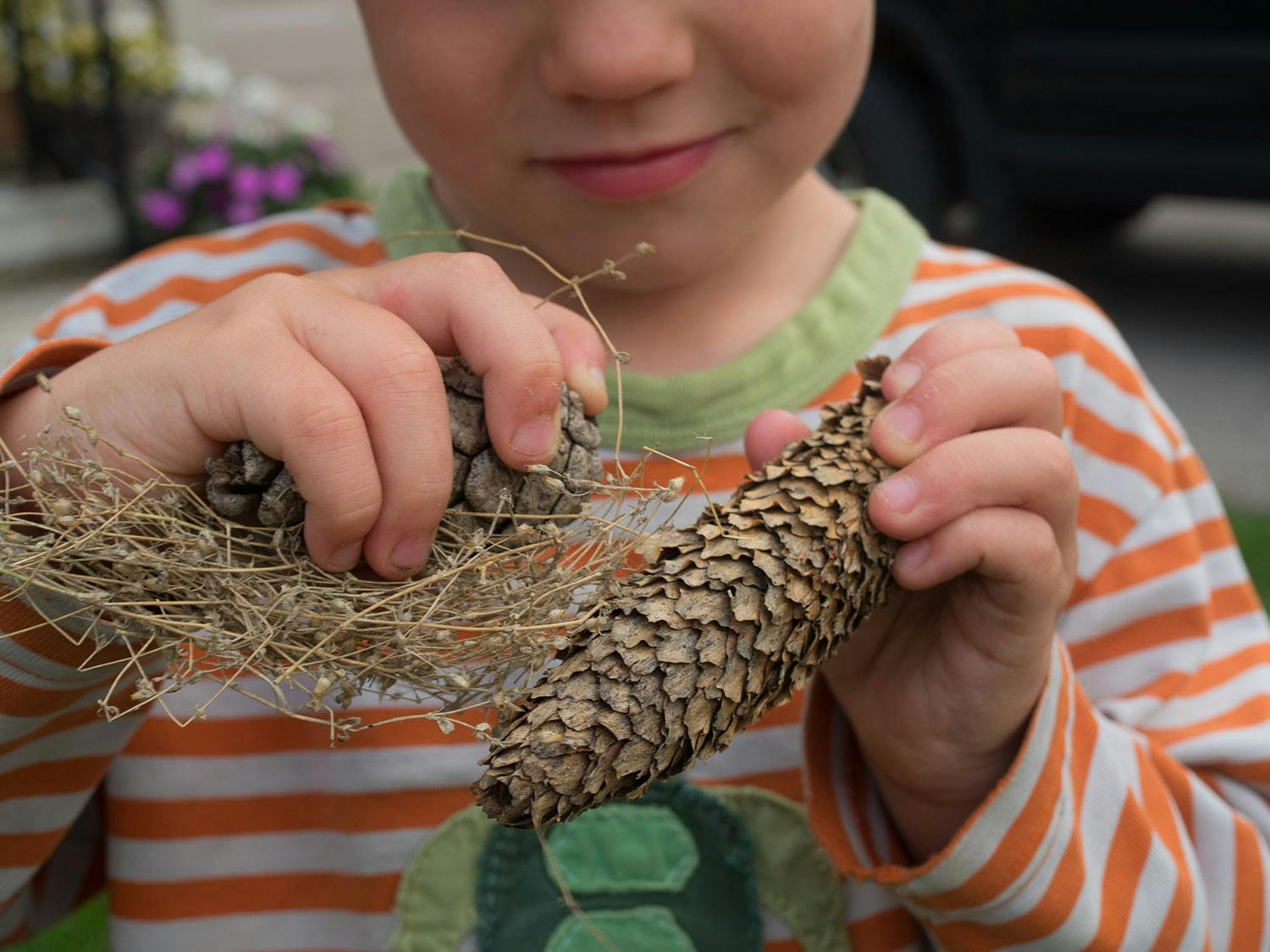More Pinecones, Less Paw Patrol
We need to help our little people find magic in the wilderness, even while mourning its loss.
As parents, we often feel vicarious joy when our kids do something we’re proud of. Common points of pride for preschoolers include drawing stick figures, tracing letters, and counting to 20. My husband and I are pretty stoked on 3-and-a-half year-old Little Grey Lamb’s fledgling BMX career. What truly makes us happy, though, is how comfortable he is in nature. Yesterday we were at a wetland by our house, and saw a creature taking a dip. “Look, Grey, a marten,” I yelled, mixing up my “m” mammals. “No, Mama — that’s a muskrat.” Beaming, I agreed.
I’m not reinforcing ecological literacy for the sake of rote-learning or for bragging rights; most folks don’t care that my child knows four different species of gull. When our kids feel at home with wild places, they become more resilient, more compassionate, and more committed to protecting the Earth that is their home.
And I should be clear: when I use the word “wild,” I’m not referring to the rare pristine places that remain untouched by humans, but rather what author Emma Marris calls the “rambunctious garden.” These are spaces that humans have influence over, and can range from weedy urban back alleys, to old fields, to woodlands, that all still unquestionably cast nature’s spell.
We’ve chosen to raise our family on a small rural property surrounded by rambunctious nature — but it’s not for everyone. We’re on an annoyingly low-flow well and a septic system, most of our community is far away, the internet is dodgy, and our actual house is a glorified 950-square-foot cabin. But it’s quiet enough to hear the stars twinkling, we can see the mountains from our window (if we stand on a chair), and we can cross-country ski right from our doorstep. Although we’re only 10 minutes from town, our 3/4 acre feels like another world.
My husband Eric and I are always discussing whether living rurally is worth it, from a sustainability perspective. We can work toward our goal of living largely off-grid by adding renewable energy sources, growing more of our own food, and biking to work whenever possible. But with two young kids, the volatile Alberta weather, and imperfect public transit, cars are still central to our life. Could anything we do offset this?
Our kids are learning to take their place between the pinecones and the pelicans.
There’s a good argument to be made about the value of living close to nature — but it’s not something I can quantify and measure against carbon emissions or natural-gas usage. It’s subtle. It’s my kids’ ability to walk steadily on uneven earth, navigating rocks and wet soil. It’s their look of wonder as they watch a heron glide over our heads. It’s the stories we tell about this place and its wild things. It’s Mini Ewe’s ability to sit by the shoreline and watch a mama goose leading her babies. It’s the fact that Little Grey can tell a marten from a muskrat.
Our kids are learning to take their place between the pinecones and the pelicans; we’re hopeful this proximity to nature will instill in them such a fierce love of the Earth that it’s part of their identity, and that they’ll become warriors when it’s threatened. We hope they’ll know how to grow a year’s worth of food, paddle a canoe to safety, and read the weather.
These skills and this love will be needed as the planet changes. According to James Watson, director of science at the Wildlife Conservation Society, only 20% of the Earth is currently classed as wilderness — and if we continue on our current path, there may be no wilderness left in 50 years.
Living on our mini-acreage allows us to parent in a way that shields our kids from this fate — for now. They wander, wonder, explore, create. But you don’t need to live surrounded by fields or woodlands to instill a sense of magic and wilderness-appreciation in your family. Here are some strategies that could work whether you live in a high-rise or a yurt:
Memory as a conservation tool
It’s worth asking ourselves what wilderness memories we’re creating, no matter where we live. In George Monbiot’s words, “without the power of memory, we cannot hope to defend the world we love.” Our children must fall in love with the world right at their doorstep, and they must never forget the wisdom, the wonder, and the value of the wild things.
Monbiot writes from a European perspective, watching as the British government makes a “farce” out of its national park system, and his fellow citizens — by forgetting — allow their ecosystems to crumble. My little flock will also see dramatic transformations in our local landscape in their lifetime.

Already the land around our house is an example of the kind of “gift” Monbiot sees being granted to powerful interest groups. Our local lake, while never exactly pristine, was its own functional ecosystem. Not long ago, after an insufficient environmental review, rights were granted to build a subdevelopment around one side of it. With no natural outflow other than the groundwater table, the lake rose, flooding both basements of low lying homes, and the delicate shoreline. The only option the county now has is to run pumps 24/7. Remarkably, the lake is now home to several new species of waterfowl. Its health is returning, but only so long as the pump runs.
Wild places are all around us: lakes, the weeds in the back alley, community gardens, your local crow roost. As I pointed out in my last column, I don’t think we should shield our kids from hard environmental truths. But nor should we let facts overtake their sense of belonging and awe. Monbiot says, “Remembering is a radical act.” With some creativity and commitment, our kids should be able to identify a starling or columbine blossom more readily than they can Paw Patrol or Pepsi. How radical would that be?!
Our kids should be able to identify a starling or columbine blossom more readily than they can Paw Patrol or Pepsi.
The family sit spot
Regardless of whether your home is urban or rural, you can create what naturalist and educator Jon Young calls a “sit spot”: an area that allows for connection with nature. You return, day after day, rooting yourself to the spot, observing, and allowing yourself to become part of its rhythms.
That said, the idea of “sitting” with a toddler and a preschooler is kind of a joke, so ours is called a “shore explore.” We’ve chosen a bit of shoreline 10 minutes from our house (or two hours if Little Grey is in a special mood). There are nesting boxes for geese, minnows in the littoral zone, waterfowl floating just beyond our reach. We can see deer, coyote, and moose tracks easily. We watch the seasons change and the animals grow and move.

In Young’s book, Coyote’s Guide to Connecting with Nature, he writes: “I spent a lot of time sitting at the one special spot and it seemed the animals accepted me as a natural part of that place. Going there felt like going home.” This is what I want my kids to feel — that nature is their home, and that they are so much a part of it that they would defend it as they would any other part of their community.
The sit spot also encourages a different relationship with the land. Storyteller Martin Shaw notes that the “difference between being from a place and of a place is your capacity to behold it.” The sit spot allows us to behold, be beholden to, and be held by, the land.
Your backyard may be better than the boreal forest an hour away.
If you’d like to try this out, here are some thoughts, inspired by an FAQ from Young’s Wilderness Awareness School:
- Go as often as possible. Daily would be awesome, but there are many days I can barely get the kids out of their pyjamas. So sometimes we go in our pyjamas, sometimes we bake cookies instead.
- Sit or explore for at least 15 minutes at a time. Activities like scavenger hunts, stories, or a wilderness journal can all help engage your kiddos.
- Pick a place that is the best balance of accessibility and wildness — your backyard may be better than the boreal forest an hour away if you have young kids and not a lot of time.
- Encourage your family to use their senses: listen, feel, smell, observe, maybe even taste if there are edibles nearby that you feel (very) comfortable identifying.
- Be patient; magic often unfolds slowly. Much of a sit spot’s beauty is watching things change over the seasons.
- Be sure you’ve checked for safety: watch for wildlife that don’t want you there, widow-maker trees, dangerous waterways, private property, noxious plants, etc.
I’ll conclude with the ideas of Rambunctious Garden’s Emma Marris:
We cling to fragments of… the ever-rarer “intact ecosystems,” but they slip through our fingers. Like slivers of soap, they shrink and disappear. And we mourn. We are always mourning, because we can’t make more of such places.
As a parent, I feel this daily; but through the mourning, I know there is magic. Even better, I know my kids already feel the spell of the wild places, regardless of where they are found.
